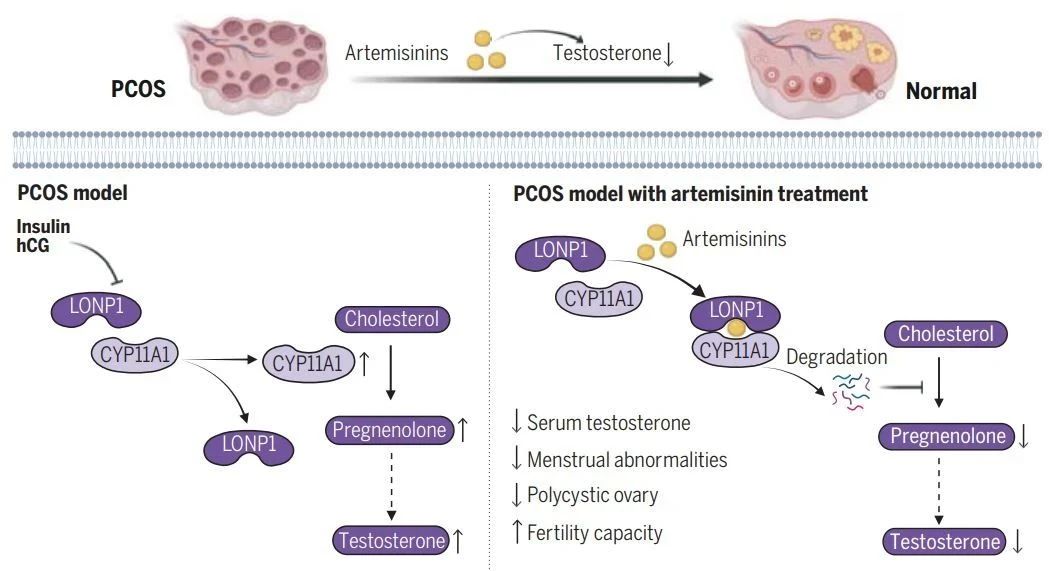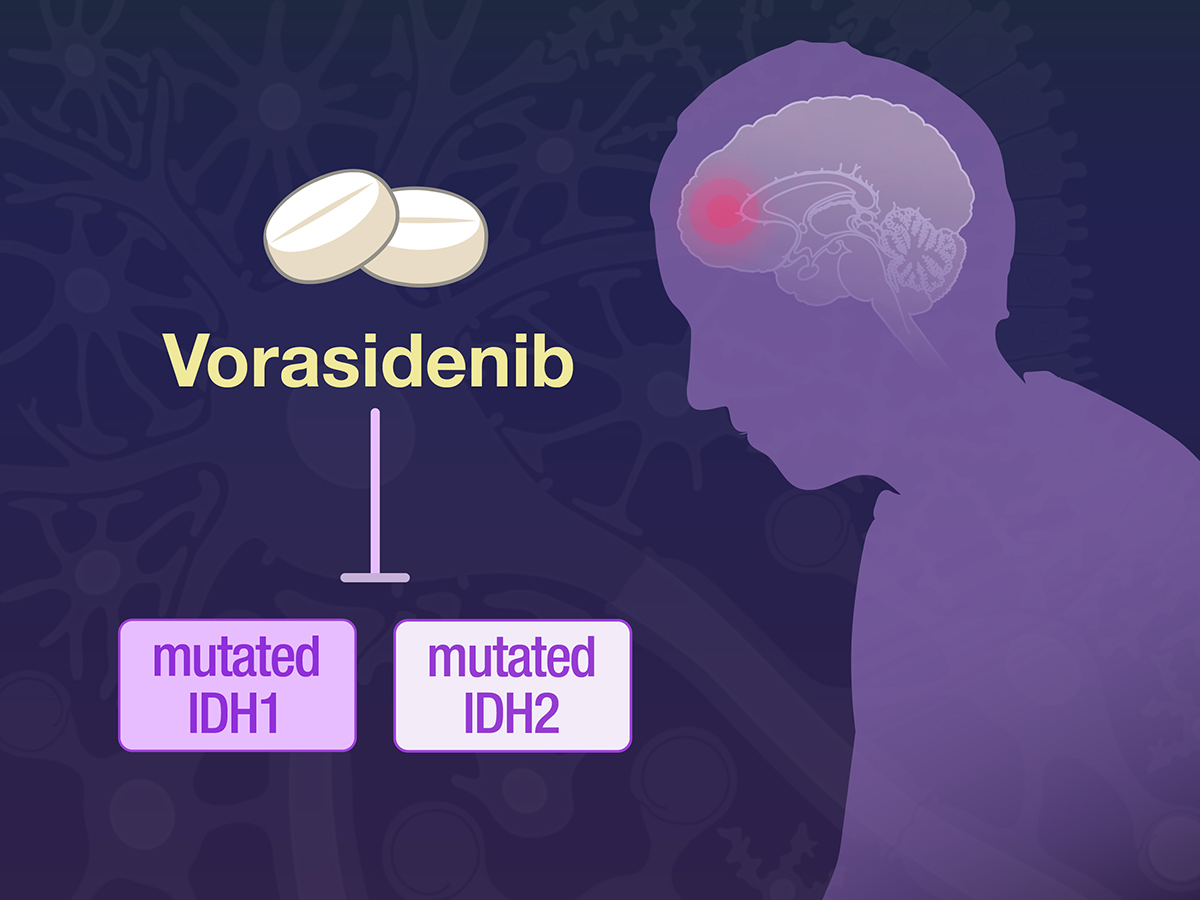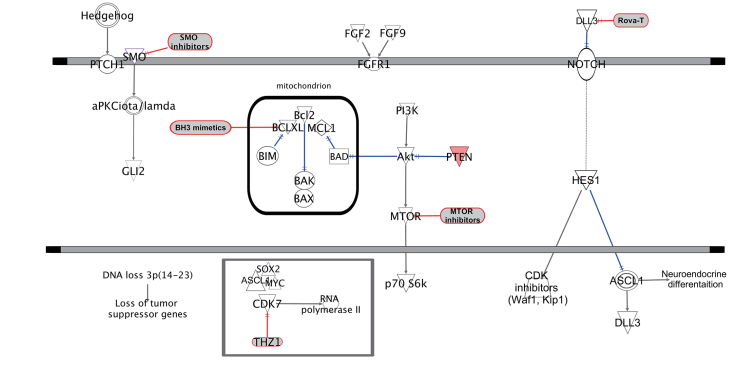A New Hope for Treating Polycystic Ovary Syndrome (PCOS)
Abstract
Artemisinins, traditionally used for malaria treatment, have been identified as a promising new therapeutic option for Polycystic Ovary Syndrome (PCOS). This research demonstrates that artemisinins can significantly ameliorate PCOS symptoms by targeting the underlying mechanisms of androgen excess. The study revealed that artemisinins enhance the degradation of CYP11A1, a key enzyme in androgen synthesis, through interaction with the enzyme LONP1. This action reduces ovarian androgen production, addressing the hormonal imbalances central to PCOS. The findings, validated in rodent models and a pilot clinical trial, show that artemisinins can reduce hyperandrogenemia, improve ovarian morphology, and restore regular menstrual cycles. This breakthrough highlights the potential for artemisinins to offer a more comprehensive and effective treatment for PCOS, paving the way for future research and therapeutic developments.
Keywords:Polycystic Ovary Syndrome (PCOS);Artemisinins;Hyperandrogenemia;CYP11A1;LONP1
Introduction
Polycystic Ovary Syndrome (PCOS) is a prevalent endocrine disorder that affects approximately 10-13% of women in their reproductive years. Characterized by symptoms such as hyperandrogenemia (excess androgen levels), ovulatory dysfunction, and polycystic ovarian morphology, PCOS often leads to severe metabolic complications, including insulin resistance and obesity. Despite its high prevalence, the treatment options for PCOS remain limited and primarily focus on managing symptoms rather than addressing the underlying causes of the disorder.
Artemisinins, a group of drugs derived from the Artemisia plant, have long been recognized for their efficacy in treating malaria. However, recent research has uncovered their potential beyond antimalarial applications. A groundbreaking study published in Science has revealed that artemisinins may offer a new therapeutic approach for treating PCOS. The study explores how these compounds can ameliorate PCOS symptoms by targeting the root cause of hyperandrogenemia.
The research demonstrates that artemisinins interact with the enzyme LONP1 to enhance the degradation of CYP11A1, a crucial enzyme in androgen synthesis. This interaction effectively reduces androgen production in the ovaries, addressing the hormonal imbalance at the heart of PCOS. The study’s findings were validated through both rodent models and a pilot clinical trial involving human patients, showing significant improvements in hormone levels, ovarian morphology, and menstrual regularity.
The discovery of artemisinins’ potential in treating PCOS marks a significant advancement in the search for comprehensive treatment options. By targeting the underlying mechanisms of androgen excess, artemisinins offer hope for more effective and lasting relief from PCOS symptoms. This new application of a well-known drug exemplifies the innovative approaches needed to tackle complex disorders like PCOS, paving the way for future research and therapeutic development.
Understanding PCOS
Polycystic Ovary Syndrome (PCOS) is one of the most common endocrine disorders affecting women of reproductive age, with a prevalence ranging from 10% to 13%. It manifests through a variety of symptoms, including hyperandrogenemia, ovulatory dysfunction, and polycystic ovarian morphology. These symptoms often lead to a spectrum of metabolic complications, such as insulin resistance, obesity, and an increased risk of type 2 diabetes and cardiovascular diseases. The exact cause of PCOS remains unclear, but it is understood to be a complex condition involving genetic, hormonal, and environmental factors.
Hyperandrogenemia, characterized by elevated levels of male hormones like testosterone, is a primary feature of PCOS. This hormonal imbalance is responsible for many of the condition’s symptoms, including irregular menstrual cycles, hirsutism (excessive hair growth), and acne. The ovaries of women with PCOS typically contain numerous small cysts and exhibit increased production of androgens, which can further disrupt the regular menstrual cycle and ovulation process.
The metabolic aspects of PCOS are also significant, as many women with PCOS experience insulin resistance, which can exacerbate androgen production and lead to weight gain. Insulin resistance is a condition where the body’s cells do not respond effectively to insulin, resulting in elevated blood glucose levels. This metabolic dysfunction not only complicates the management of PCOS but also increases the risk of developing serious long-term health issues.
Given its multifaceted nature, PCOS presents a substantial challenge for effective treatment. Current treatment options are largely symptomatic and include lifestyle interventions, hormonal contraceptives, anti-androgens, and insulin-sensitizing agents. However, these treatments often do not address the underlying causes of PCOS and can have varying degrees of success and side effects. As a result, there is an ongoing need for innovative therapeutic strategies that can provide more comprehensive and targeted management of PCOS.
Current Treatments for PCOS
Polycystic Ovary Syndrome (PCOS) presents a multifaceted challenge for effective treatment due to its complex and varied symptoms. Current treatment strategies primarily focus on managing individual symptoms rather than addressing the underlying causes of the disorder. This symptomatic approach often leads to incomplete relief and varied success rates among patients.
One of the most common treatments for PCOS is the use of combined oral contraceptives (COCs). COCs help regulate menstrual cycles, reduce androgen levels, and alleviate symptoms such as hirsutism and acne. However, while COCs can manage some of the symptoms of PCOS, they do not improve fertility or address the metabolic aspects of the syndrome. Furthermore, long-term use of COCs can have side effects, including an increased risk of vascular thromboembolism.
Anti-androgens are another class of medications used to manage hyperandrogenism in PCOS. These drugs, such as spironolactone, can effectively reduce excessive hair growth and acne by blocking androgen receptors or inhibiting androgen production. However, they can also have side effects and are often used in conjunction with other treatments.
Insulin-sensitizing agents, such as metformin, are commonly prescribed to address insulin resistance in PCOS patients. Metformin improves insulin sensitivity and can help regulate menstrual cycles and promote ovulation, making it beneficial for women with PCOS who are trying to conceive. Additionally, metformin has been shown to reduce androgen levels and improve metabolic parameters. Despite its benefits, metformin can cause gastrointestinal side effects and is not effective for all patients.
Lifestyle interventions, including diet and exercise, are fundamental components of PCOS management. Weight loss through lifestyle changes can significantly improve insulin resistance, reduce androgen levels, and restore ovulatory function. However, lifestyle modifications require sustained effort and commitment, and their effectiveness can vary depending on individual factors.
Given the limitations of current treatments, there is a clear need for innovative therapeutic strategies that can provide more comprehensive and targeted management of PCOS. Emerging research, such as the study on artemisinins, offers hope for new treatments that address the root causes of PCOS and provide more effective symptom relief with fewer side effects.
Artemisinins: Beyond Malaria & The Study on PCOS
Artemisinins, a group of drugs derived from the Artemisia annua plant, have long been recognized for their efficacy in treating malaria. Discovered in the 1970s by Chinese scientist Tu Youyou, artemisinins have since become a cornerstone in the fight against malaria, earning a Nobel Prize in Physiology or Medicine in 2015 for their discovery. These compounds work by generating reactive oxygen species that damage the malaria parasite, leading to its death. However, recent research has uncovered their potential beyond antimalarial applications, particularly in the treatment of Polycystic Ovary Syndrome (PCOS).
The Study: Exploring Artemisinins for PCOS
A groundbreaking study published in Science has revealed the potential of artemisinins as a new therapeutic approach for treating PCOS. This study aimed to investigate the effects of artemisinins on testosterone levels, estrous cycles, and polycystic ovarian morphology in rodent models and human patients. The research team employed a combination of in vivo and in vitro methods to explore how artemisinins influence ovarian testosterone synthesis.
In rodent models, artemisinin analog artemether was found to significantly improve hyperandrogenemia, irregular estrous cycles, polycystic ovarian morphology, and fertility. The mechanism behind these improvements was identified as the interaction between artemisinins and the enzyme LONP1, which enhances the degradation of CYP11A1, a crucial enzyme in androgen synthesis. By promoting CYP11A1 degradation, artemisinins effectively reduce androgen production in the ovaries, addressing one of the key hormonal imbalances in PCOS.
Key Findings
The study’s findings were validated through a series of experiments involving both rodent models and a pilot clinical trial with human patients. In the rodent models, the researchers observed that artemisinins significantly reduced serum testosterone levels, restored regular estrous cycles, and improved ovarian morphology. These results were consistent across different models of PCOS, including those induced by dehydroepiandrosterone (DHEA) and human chorionic gonadotropin (hCG).
Mechanistically, the study revealed that artemisinins directly target LONP1, enhancing its interaction with CYP11A1 and promoting its degradation. This interaction is crucial, as CYP11A1 catalyzes the initial step in the biosynthesis of androgens from cholesterol. By reducing CYP11A1 levels, artemisinins effectively lower androgen production, alleviating the hyperandrogenemia that drives many of the symptoms of PCOS.
The pilot clinical trial conducted on human patients further supported these findings. Patients treated with dihydroartemisinin showed significant reductions in serum testosterone levels, improvements in ovarian morphology, and a return to regular menstrual cycles. These clinical results underscore the potential of artemisinins as a promising treatment for PCOS, offering a new avenue for addressing both the reproductive and metabolic aspects of the disorder.
Benefits of Artemisinins for PCOS
The discovery of artemisinins’ potential in treating PCOS marks a significant advancement in the search for comprehensive treatment options. By targeting the underlying mechanisms of androgen excess, artemisinins offer hope for more effective and lasting relief from PCOS symptoms. Unlike traditional treatments that often focus on symptom management, artemisinins address the root cause of hyperandrogenemia, providing a more holistic approach to treatment.

Fig 1. Artemisinins inhibit ovarian androgen synthesis and relieve PCOS.
Future Prospects and Research
While the study presents promising results, further research is needed to confirm the long-term efficacy and safety of artemisinins in larger and more diverse populations. Future studies should also explore the development of new artemisinin derivatives that could enhance their therapeutic potential while minimizing side effects. The novel application of a well-known drug exemplifies the innovative approaches needed to tackle complex disorders like PCOS, paving the way for future therapeutic developments.
Benefits of Artemisinins for PCOS & Future Prospects
The recent discovery of artemisinins’ potential in treating Polycystic Ovary Syndrome (PCOS) marks a significant advancement in the field of endocrinology and reproductive health. PCOS is a multifaceted disorder characterized by hyperandrogenemia, ovulatory dysfunction, and polycystic ovarian morphology. Traditional treatments have primarily focused on symptom management rather than addressing the underlying causes, leading to varying degrees of success and potential side effects. Artemisinins, however, offer a novel approach that targets the root cause of androgen excess, providing a more comprehensive and effective treatment option for PCOS.
Benefits of Artemisinins for PCOS
Artemisinins exert their therapeutic effects by interacting with the enzyme LONP1, which enhances the degradation of CYP11A1, a crucial enzyme in androgen synthesis. This mechanism effectively reduces androgen production in the ovaries, addressing the hyperandrogenemia that drives many of the symptoms of PCOS. By targeting this fundamental hormonal imbalance, artemisinins offer several significant benefits:
- Reduction of Hyperandrogenemia: By decreasing androgen levels, artemisinins can alleviate symptoms such as hirsutism, acne, and irregular menstrual cycles. This reduction in androgen levels addresses one of the primary drivers of PCOS, providing more effective symptom relief.
- Improvement in Ovarian Morphology: The study found that artemisinins improved ovarian morphology in rodent models and human patients. This improvement includes a reduction in cystic follicles and normalization of ovarian function, which can enhance fertility and overall reproductive health.
- Restoration of Regular Menstrual Cycles: Many women with PCOS experience irregular or absent menstrual cycles due to hormonal imbalances. Artemisinins have been shown to restore regular menstrual cycles, which is crucial for both reproductive health and overall well-being.
- Potential Metabolic Benefits: Although the primary focus of the study was on reproductive health, artemisinins may also offer metabolic benefits. Previous research has indicated that artemisinins can improve insulin sensitivity and promote metabolic homeostasis, which could be beneficial for PCOS patients who often struggle with insulin resistance and obesity.
Future Prospects and Research
While the initial findings are promising, further research is needed to fully understand the long-term efficacy and safety of artemisinins for PCOS treatment. Future studies should aim to address several key areas:
- Long-Term Safety and Efficacy: Large-scale clinical trials are necessary to confirm the long-term safety and efficacy of artemisinins in diverse populations. These studies should monitor for potential side effects and evaluate the sustained benefits of treatment.
- Development of New Derivatives: Researchers should explore the development of new artemisinin derivatives that could enhance therapeutic efficacy while minimizing potential side effects. Optimizing the molecular structure of artemisinins could lead to more effective and targeted treatments.
- Understanding Mechanisms: Further investigation into the precise mechanisms by which artemisinins interact with LONP1 and CYP11A1 will provide deeper insights into their therapeutic potential. Understanding these mechanisms could also reveal additional targets for drug development.
- Metabolic Effects: Given the metabolic complications associated with PCOS, it is important to explore the potential metabolic benefits of artemisinins in more detail. Studies should assess their impact on insulin resistance, weight management, and overall metabolic health.
- Personalized Medicine: Future research should consider the potential for personalized medicine approaches, tailoring artemisinin-based treatments to individual patient profiles. This could enhance treatment efficacy and reduce the risk of adverse effects.
The discovery of artemisinins’ potential in treating PCOS represents a significant breakthrough in reproductive health. By targeting the underlying mechanisms of androgen excess, artemisinins offer a promising new therapeutic approach that could provide more effective and comprehensive relief for women with PCOS. Continued research and development will be crucial to fully realize the potential of these compounds and bring new hope to millions of women affected by PCOS.
Conclusion
The discovery of artemisinins’ potential in treating Polycystic Ovary Syndrome (PCOS) represents a significant advancement in the field of reproductive health. This study demonstrates that artemisinins can ameliorate PCOS symptoms by targeting the underlying mechanisms of androgen excess, specifically through the interaction with LONP1 to degrade CYP11A1, thereby reducing ovarian androgen synthesis. The research findings, validated in both rodent models and a pilot clinical trial with human patients, highlight the comprehensive benefits of artemisinins, including the reduction of hyperandrogenemia, improvement in ovarian morphology, and restoration of regular menstrual cycles. These promising results pave the way for further research to confirm the long-term efficacy and safety of artemisinins in larger and more diverse populations. Additionally, the development of new artemisinin derivatives could enhance therapeutic outcomes and minimize side effects. By addressing the root cause of PCOS, artemisinins offer a novel and potentially more effective treatment option for millions of women affected by this disorder. This breakthrough underscores the importance of innovative approaches in tackling complex endocrine conditions and opens new avenues for therapeutic development in PCOS management.
References
- Liu, Y., Jiang, J., Du, S., Mu, L., Fan, J., Hu, J., Ye, Y., Ding, M., Zhou, W., Yu, Q., Xia, Y., Xu, H., Shi, Y., Qian, S., Tang, Y., Li, W., Dang, Y., Dong, X., Li, X., Xu, C., & Tang, Q. (2024). Artemisinins ameliorate polycystic ovarian syndrome by mediating LONP1-CYP11A1 interaction. Science, 384(6187), eadk5382.
- Norman, R. J., Dewailly, D., Legro, R. S., & Hickey, T. E. (2007). Polycystic ovary syndrome. The Lancet, 370(9588), 685-697.
- Fauser, B. C. J. M., Tarlatzis, B. C., Rebar, R. W., Legro, R. S., Balen, A. H., Lobo, R., Carmina, E., Chang, J., Yildiz, B. O., Laven, J. S., Boivin, J., Petraglia, F., & Wijeyeratne, C. N. (2012). Consensus on women’s health aspects of polycystic ovary syndrome (PCOS): The Amsterdam ESHRE/ASRM-Sponsored 3rd PCOS Consensus Workshop Group. Fertility and Sterility, 97(1), 28-38.e25.
- Diamanti-Kandarakis, E., & Dunaif, A. (2012). Insulin resistance and the polycystic ovary syndrome revisited: An update on mechanisms and implications. Endocrine Reviews, 33(6), 981-1030.
- Legro, R. S., Arslanian, S. A., Ehrmann, D. A., Hoeger, K. M., Murad, M. H., Pasquali, R., & Welt, C. K. (2013). Diagnosis and treatment of polycystic ovary syndrome: An Endocrine Society clinical practice guideline. The Journal of Clinical Endocrinology & Metabolism, 98(12), 4565-4592.
- Teede, H. J., Misso, M. L., Costello, M. F., Dokras, A., Laven, J., Moran, L., Piltonen, T., & Norman, R. J. (2018). Recommendations from the international evidence-based guideline for the assessment and management of polycystic ovary syndrome. Human Reproduction, 33(9), 1602-1618.
- Goodman, N. F., Cobin, R. H., Futterweit, W., Glueck, J. S., Legro, R. S., & Carmina, E. (2015). American Association of Clinical Endocrinologists, American College of Endocrinology, and Androgen Excess and PCOS Society disease state clinical review: Guide to the best practices in the evaluation and treatment of polycystic ovary syndrome—Part 2. Endocrine Practice, 21(12), 1415-1426.
- White, N. J. (2008). Qinghaosu (Artemisinin): The Price of Success. Science, 320(5874), 330-334.




